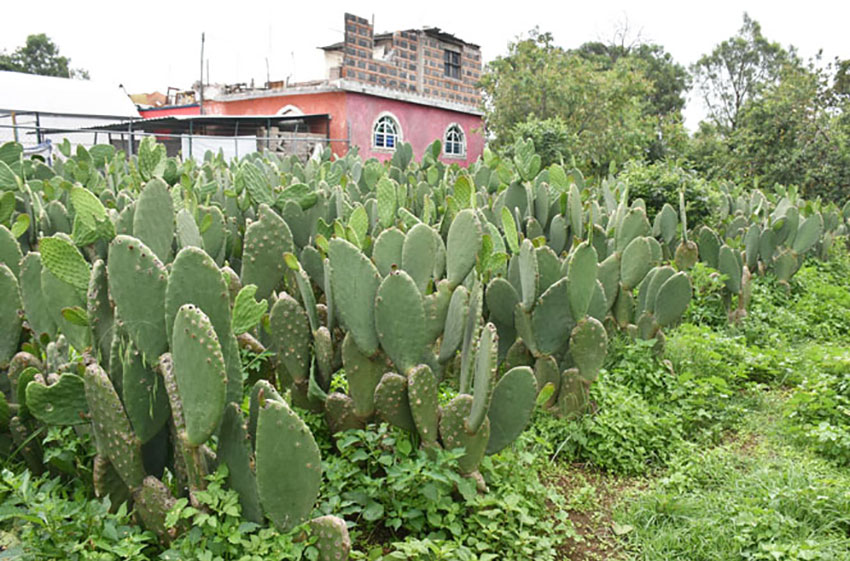There aren’t many people who upon passing a prickly pear cactus would think, “Well, that looks like a tasty and nutritious plant.”
Its stems tend to be thick and uninviting and its pads are covered with long needles. Worse, tucked in between the long needles are a multitude of tiny, thin and practically invisible needles which, once embedded in your body are especially challenging to remove (suggested methods include using nylon stockings or glue).
But somehow, around 20,000 years ago, hunter-gatherers in the Valley of México recognized it as a food source. It was then domesticated approximately 9,000 years ago by the Chichimecas and, along with maguey, corn and beans, was a primary food source for many indigenous groups. It continues to be an important food for Mexicans today.
The Centro de Acopia (Collection Center) in Milpa Atla, one of Mexico City’s boroughs, isn’t really that big; maybe half a city block. But it bustles with activity every day from 2:30 in the morning until 6:00 in the evening as campesinos from across Milpa Alta truck in their nopal, set up their stands and sell what they have.
Although all the campesinos cultivate small fields of only a few acres, an incredible amount of nopal passes through the center. “Every day, we have 250 tonnes of nopal [brought here],” said Juan Gutiérrez, the center’s administrator. “In a year, approximately 91,200 tonnes.”

Although nopal is grown throughout Mexico, it’s most closely associated with Milpa Alta which produces 300,000 tonnes of nopal annually, accounting for 90% of what’s grown in Mexico City.
Although Milpa Alta is now known as a center for nopal production, growing it in quantity didn’t happen until the middle of the last century. “Years ago, people grew corn and maguey to make pulque,” said Zarai Loza Jurado, whose family has been growing nopal for generations.
“When beer became more popular, people stopped growing maguey and they needed another source of income, so they started growing nopal. Nopal is harvested all year long, so people can earn more than they can from corn, which is only harvested once a year.” Also, Milpa Alta doesn’t have water all year round and nopal does just fine when there isn’t any.
Loza took me to her family’s property, which looked to be about an acre. “Right now, four generations of the family are working in nopal,” she said. “We don’t produce a great quantity but our quality is better. We take care of the environment. Here, we don’t use the word ‘organic.’ We say that ‘we use ancestral methods’ or ‘we farm as our grandparents did.’ We say that this is the resistance of the pueblo.”
Nopal remains an important food source for several reasons: it’s abundant, it’s found in markets across Mexico and it’s inexpensive: a kilo in local markets costs around 15 pesos. “Many people, especially campesinos, cannot afford meat or chicken … not even fish,” said Loza. “So [nopal] is a nutritious meal, especially when served with rice and beans.”
She’s right. Among other things, nopal is a good source of vitamins B and C, calcium, potassium, and fiber. It may be used to treat burns and small cuts, has been shown to control diabetes and lower cholesterol levels and may have anti-carcinogenic properties. And perhaps just as important, it’s tasty. Given its popularity, it should come as no surprise that there are countless ways to prepare it.

It’s best to buy nopal that has already had its needles removed; vendors in the markets are quite adept at this. Small pads may be eaten raw in salads but it’s recommended to toss them with salt for several minutes to remove the gelatinous substance inside. A simple way to prepare larger pads is to score them gently with a knife, brush them with oil and then grill them. These are then typically wrapped in a tortilla.
For cooking, pads should be chopped and boiled for about 20 minutes to release that gelatinous substance, and then thoroughly rinsed. I like to combine these with tomatoes, corn and onions to make a stew. Dried nopal is also used to add flavor to meat, soups and salads. The fruit of the cactus — called tuna — is eaten raw and used in jellies and desserts. I admit to being taken aback when I first saw tuna ice cream advertised.
The Serralde Nieto family has been growing for 10 years and started a small, family-owned company that has expanded the ways nopal is used. “We sell many nopal-based products,” said Eloise, the family matriarch. “We have tortillas, cookies, jellies, and nopal enchilada [dried nopal dusted with chile piquín], as well as soaps, shampoos and creams.”
And now there’s one more way to enjoy this cactus: Nopalea C, a beer.
It’s a lager that was developed by Nopalea Industries in Nuevo León in collaboration with with the University of Prague and the Association of Brewers in Czechoslovakia. Unfortunately, its distribution is still fairly limited through several stores in Nuevo León and just a couple in other states.
The company’s website highlights the health benefits of drinking their beer, promoting it as a source of vitamins and minerals as well as fiber. But they also note that it would take 14 beers to provide the recommended daily intake of 40 grams of fiber.
But take heart: a 2014 study found that extract from nopal can reduce the severity of hangovers. So if you were inclined (and able) to drink 14 Nopalea Cs to get your daily fiber intake, you may find yourself slightly less groggy the next day.
Joseph Sorrentino writes from San Gregorio Atlapulco, Mexico City. He is a regular contributor to Mexico News Daily.
